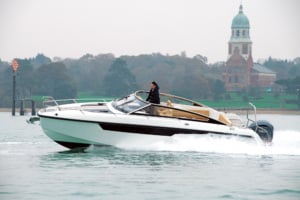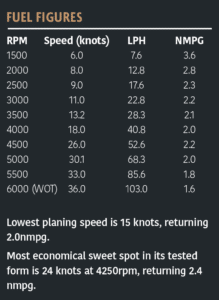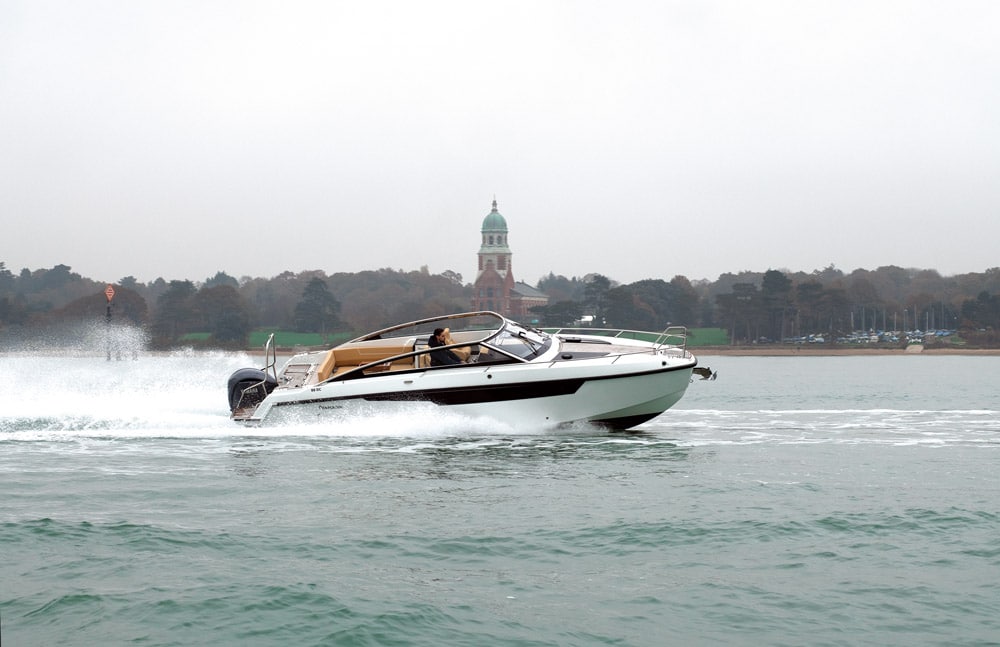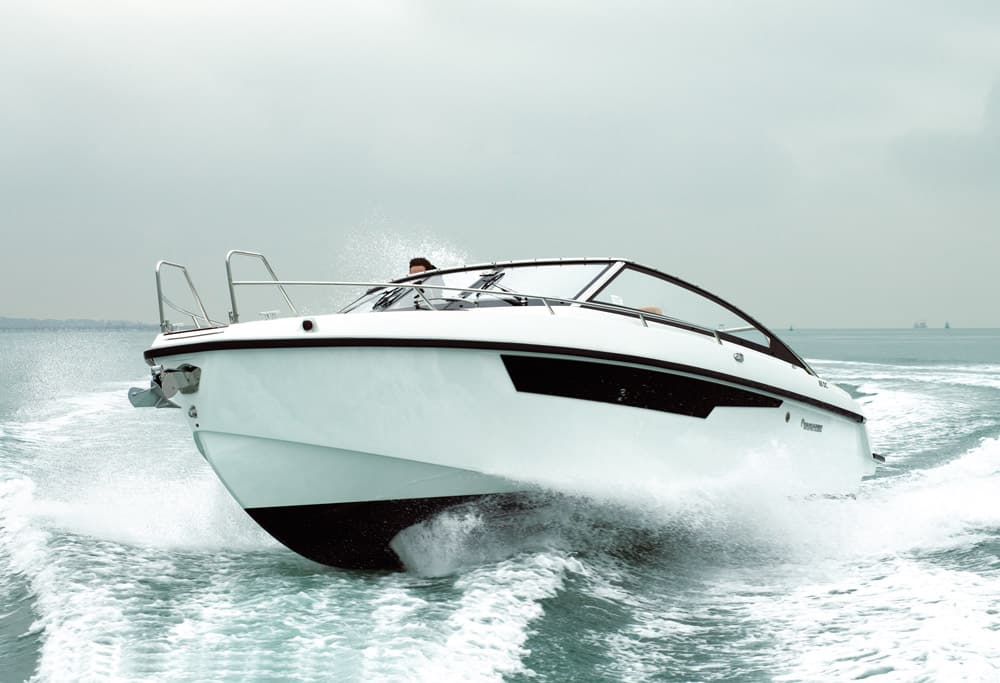Greg Copp reports on a versatile sports boat that is as tough as it is stylish and that has a number of powerful engine options available.
 This Finnish company has always focused on middleweight sports boats, and as a result does a very good job of it. The Yamarin 88 DC Premium is the flagship of a series of day cruisers ranging in size from 6m to 8.8m. Available with outboard engines from 300hp to 425hp, the 2.7-tonne 88 DC offers an exciting drive, while still providing the facility to overnight comfortably. Due to Yamarin’s close association with Yamaha, the single power options are realistically simple: F300, XTO 375 or XTO 425.
This Finnish company has always focused on middleweight sports boats, and as a result does a very good job of it. The Yamarin 88 DC Premium is the flagship of a series of day cruisers ranging in size from 6m to 8.8m. Available with outboard engines from 300hp to 425hp, the 2.7-tonne 88 DC offers an exciting drive, while still providing the facility to overnight comfortably. Due to Yamarin’s close association with Yamaha, the single power options are realistically simple: F300, XTO 375 or XTO 425.
This craft may have been designed and built in Baltic waters, but with its big cockpit it clearly leans towards Mediterranean use. That said, it is popular in its home climate, and complete with Webasto heating and a quickly erected cockpit camper cover it lends itself perfectly to our home shores. Its style is what would have been termed ‘retro’ a few years back, but with the upsurge in steep stem bows and rectangular windscreens, this Yamarin is contemporary, but clearly Scandinavian. The thick stainless steel windscreen frame, gas strut-enabled windscreen gate and ‘patrol boat-like’ windscreen wipers, though possibly overengineered, are pleasing to see – hinting at what lies within.
- Few 29ft sports boats can boast a cockpit this size.
- The cockpit cover set easily folds away.
- Twin Garmin 16in MFDs make for easy reading.
- With two big MFDs you need two big comfy seats.
- Easy foredeck access.
- The windscreen wipers are overengineered for the job.
Access is via either of the flanking bathing platforms that sit either side of the engine. These lead to the raised aft deck section that runs across the transom area, and under each quarter sits a warps/fender locker. Between the quarter lockers there is a central deck section, which can be raised to accommodate trimming the engine clear of the water when moored. Yamarin have even thought to fit rubber rollers on the aft edge of this section to prevent the engine being chaffed. Just behind the cockpit seating lies a thin area of deck, which opens to reveal the cockpit cover locker. Already fitted to its frame, this cover is easily pulled out into position when the weather demands it. With the table fitted, the actual depth of the cockpit is deceptive, and you need the step that sits inside the starboard quarter of the cockpit to step in comfortably. This deep cockpit provides anyone sitting aft with a good degree of weather protection, and on our near-zero-degree test day this certainly proved to be the case. Unless you have a need for the cockpit table, I would consider removing it when underway, otherwise it tends to restrict forward/aft movement as you have to step around the seating behind the helm, while at the same time stepping up to the raised deck in the forward section of the cockpit. The table also serves the purpose of providing a base for a sunbed infill, the cushions for which are stored in the under-sole cabin. This ‘cabin’, for want of a better word, has enough headroom for a child’s doll – literally. It can be accessed either from the forward cabin or through a hatch under the seating behind the helm. A child or two could sleep in it, providing they don’t mind ‘inserting’ themselves through the under-seating hatch, or crawling in from the main cabin. Adults would have to be ‘wraith-like’ to get in, but it is possible. To be fair, it is a good use of space that would normally be relegated to being under-deck storage, which it will likely be used for anyway.
Cooking and refreshments are provided for by a small cockpit galley, comprising a gas hob, sink and fridge. There are also cutlery drawers under the port-side forward seat, and a fold-out galley top extension next to the sink/hob. Foredeck access is good via the windscreen gate, which is supported by a gas strut. The steps leading up are large and certainly not steep, and once on the foredeck you have a wide teak walkway leading to the open pulpit, and an anchor locker housing an electric windlass. One thing I will say is that the cleats, both forward and aft, are a touch on the small side for a 29-footer.
Below decks is the typical cabin/heads set-up. The starboard side heads has a toilet and sink, with a pull-out shower rose that doubles as a tap. The internal fit-out is of a high standard, but headroom is limited, so I doubt many will actually use the shower. The double bed is of a reasonable size, while the overhead smoked Perspex roof panels, combined with portholes and hidden mood lighting, provide a good degree of light. Storage is either a large neatly lined locker beneath the bed or a hanging locker on the port side.
Driving the 88 DC
 From my perspective, the moment I got behind the wheel I needed to stand. This primarily was because unless I settled down into the seat with the seat bolster down, the top of the windscreen was in my line of sight. Of course, this is relative, and to be fair, for a standing position it is quite secure, even when cornering hard. The wheel and throttles come to hand perfectly, and with twin 16in Yamarin MFDs you can pick up on what you need to know in the blink of an eye. They can be configured as you want them, so should you need a detailed view of the seabed, a chart display and engine/system data on view, it is easily done. I can honestly say I have yet to see this level of on-screen information in a 29ft boat.
From my perspective, the moment I got behind the wheel I needed to stand. This primarily was because unless I settled down into the seat with the seat bolster down, the top of the windscreen was in my line of sight. Of course, this is relative, and to be fair, for a standing position it is quite secure, even when cornering hard. The wheel and throttles come to hand perfectly, and with twin 16in Yamarin MFDs you can pick up on what you need to know in the blink of an eye. They can be configured as you want them, so should you need a detailed view of the seabed, a chart display and engine/system data on view, it is easily done. I can honestly say I have yet to see this level of on-screen information in a 29ft boat.
The first point I will make in terms of performance and economy is that this boat, having been launched the previous day, was underpropped. I was warned this was likely, and it certainly was the case. Top speed was down to 36 knots with the engine running at 6000rpm with maximum trim on the outboard. It had to reach 3750rpm before it was planing at 15 knots, and its slow cruising speed of 24 knots needed the motor spinning at 4250rpm. The Yamaha F300 is a great motor, whose broad spread of power would normally have had this boat planing at around 3250rpm, and at 4250rpm it would have been running close to 30 knots. In terms of top speed, I would have expected it to have reached 40 knots.
In terms of handling, the Yamarin is very sure-footed. Hard turns will not produce any hull slip, and the wide beam provides great stability with limited heel – ideal for water sports. Consequently, you could have expected a hard ride when hitting sharp ridges of water at speed, but this was not the case. The forward section of the hull is discreetly sharp, contrasting with the wider chine sections further aft. The result is a good bit of forward cutting power, and it seems to work very well. Combined with a typically sturdy Scandinavian hull, there were no complaints when running through the sharp wake of a fishing boat at 35 knots. It would have been nice to have had some suitably testing weather conditions, but that was sadly not to be. However, having driven Yamarins in the past in their home waters, I have little doubt that the 88 DC can step up to the mark when needed.
- This aft section provides lockers for warps and fender storage.
- The table drops down to create this sunbed.
- Access to the under-sole cabin from cockpit.
Verdict
This is one of the few boats I have tested with the basic engine option. This is because the F300 is a realistic engine choice for most people, providing, of course, it has the correct propeller. However, there are other engine options, namely the XTO 375 and XTO 425, which if you intend to have more than a family on board could be a good idea. The XTO 425 is reported to push the 88 DC to 49 knots, which may be a bit optimistic, but either of these bigger engines would suit this boat very well – and release its full potential. Our test boat was the 88 DC Premium, which comes with a higher level of basic specification than the standard 88 DC – for example, two MFDs as opposed to one, teak decking and a stainless steel windscreen frame, as opposed to anodised aluminium. Whichever model you choose, the Yamarin 88 DC will stack up well against its competitors, in more than just price. Its open sports boat looks, great performance potential and rock-solid Yamaha reliability will inevitably create a strong fan base.
What we thought
For
- Very high-quality fit, finish and build quality
- Good dash display
- Three forward-facing bucket seats
- Predictable sure-footed handling
- Soft ride
- Cockpit space
- Easy foredeck access
Against
- Access to the under-sole cabin is really limited to children
- The helm seat could be slightly higher
- Relatively small cleats
Specifications
- LOA: 8.80m
- Beam: 2.95m
- Draught: Max. 0.70m
- Transom deadrise angle: 19 degrees
- Displacement: 2700kg
- Power options: Yamaha F300 to F425 outboards
- Fuel capacity: 300L
- RCD category: C for 10
- Test engine: 300hp Yamaha F300
Performance
- 36.0 knots (2-way average), sea conditions moderate, wind F3, with 70% fuel, 2 crew
Price
- As tested: £144,950 (inc. VAT)
Contact
























